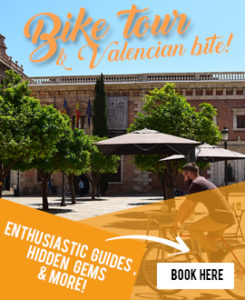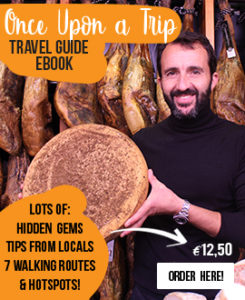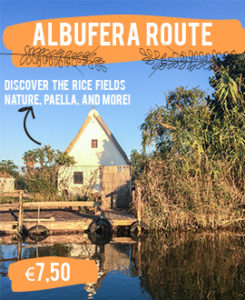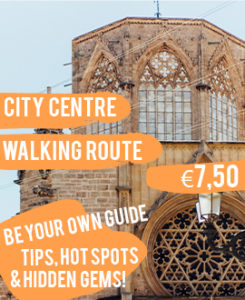Small streets, hidden plazas, unique stories and facts…Valencia is a mysterious city full of secret places where many visitors of the city pass by without even noticing. Even when you’ve visited the city before you’ll discover new things every time. Do you want to get to know all the hidden gems of Valencia? Discover the following ten secrets of Valencia!
1. Funky fishing district
Behind the port and Las Arenas beach you will find El Cabanyal, the old fishing district. This neighbourhood used to be run-down and was known as a bad place to walk around at night. The former mayor of Valencia even planned to break down the whole neighbourhood. Nowadays, this area is up and coming and getting more popular under locals and travellers. More and more bars are located in El Cabanyal, and music events and festivals are organized on a regular basis. Wander through this vivid area and admire the small, coloured fishing houses. Visit the Mercado Cabanyal and have some tapas and wine at Bodega Anyora. Longing for a cold cerveza after a long day at the beach? Bar La Paca is the place to be.
2. Museum of Silence
Are you looking for a nice walking route over a cemetery? Needless to say, this sounds quite crazy… But this is exactly what Museo de Silencio offers! The Cementerio General de Valencia was a cemetery opened in 1807. It was opened after it became forbidden to add cemeteries to each church in the historic centre. Special persons have been buried in this cemetery, for example the famous Valencian writer Vicente Blasco Ibañez. You can follow four different routes: important women, illustrious people, popular people and 18 lifes & 18 silences. This lasts route shows you the graves of important people from Valencia. Do you speak a little Spanish? Then you can download an app where you can easily follow all the routes.
Location
Santo Domingo de Guzman 27
46017 Valencia
Website
Opening hours
Monday until Saturday: 09:00 – 18:00
Sunday and holidays: 09:00 – 14:00
3. An unknown ‘Jewish’ gem
Pay attention, because most people pass by without noticing this hidden gem! You have to look up to spot this special building. Casa Judía, built in 1930, is cheerfully decorated with many blue, green and orange colours. The house is called Casa Judía (Jewish house), because there is a Star of David on the gate of the building. Until now it is not quite clear why this star is on the gate. Was it an addition by the architect? Or was it a wish of the purchaser named José Salom who was probably Jewish himself?
Location
Carrer de Castelló 20
4. Dinner with a view on the City of Arts and Sciences
Looking for a beautiful and affordable view on the City of Arts and Sciences? This may sound like a dream, but at Restaurant Vertical this dream becomes reality. This restaurant offers relatively affordable lunch and dinner menus. The lunch menu costs €55 and the dinner menu costs €70. Enjoy a delicious meal while enjoying the incredible view on the City of Arts and Sciences.
Good to know: the restaurant is located at the shopping centre Aqua. To get there you need to take the elevator to the top floor of hotel Aqua. If you make a reservation, a table is guaranteed!
Location
Centro Comercial Aqua
Carrer Luís García Berlanga 19
46022 Valencia
Website
Opening hours
Monday until Sunday: 13:30 -15:30 and 20:30 -23:30
5. Romantic hidden garden
Visiting Valencia? The famous Turia Park is almost impossible to miss! This long green park wanders around the northern part of the centre. But did you know there is a smaller park near the Turia Park, which is also definitely worth a visit? The beautiful gardens Jardines de Monforte are only a short distance from the Turia Park. Many visitors skip these gardens because they are hid really well. This is a shame, because this is one of the beautiful hidden gems of Valencia! Visit this park if you want to enjoy a quiet environment. Take a seat on one of the benches, bring your book and relax. That’s what we call ‘Disfruta la vida’!
Fun fact! The Jardines de Monforte is a popular location for couples to get married and take wedding photos. Especially the long arch with the most beautiful pink flowers gets often chosen for the most romantic photos.
Good to know: the Facultats and Alameda metro stations are within walking distance of Jardines de Monforte. Fancy a walk? From the central square Plaza Ayuntamiento it’s only a 20 to 25 minute walk to the Jardines de Monforte. You can also cycle to the park!
Location
Carrer de Montfort
46010 Valencia
6. Valencia as the largest brothel of Europe
In The Middle Ages Valencia
was known for its prostitution. This is almost unimaginable if you keep in mind
that Valencia is a Catholic city. From 1356 to 1671, Valencia used to be the
largest brothel in Europe. This brothel was not hidden somewhere in a slum; it
was situated in the middle of the centre, next to the famous silk exchange Lonja
de la Seda. This may be one of the reasons why you can see many erotic images
around La Lonja. The brothel had a good organization and they had some clear
rules. For example, men were not allowed to have a relationship with the ladies
who worked in the brothel. This did not stop 280 men: they ignored this rule
and were eventually fined. In those days, you could also get fines when a Jew
or Muslim had a relationship with a Christian.
In the seventeenth century the resistance against brothels and prostitution was
growing. Thus, a large part of mass prostitution disappeared at the end of the
seventeenth century.
Remarkable fact: one of the last prostitution areas in Valencia was the monastery of San Gregorio. Nowadays Teatro Olympia is located in this building.
7. Roman remains under the cathedral
The Romans founded Valencia in 138 BC. They nicknamed the city ‘Valentia Edetanorum’. You can still find Roman influences in Valencia. For example, the Romans started with the irrigation channels and dams that the Moors (read about them at secret 8 on this page) would later elaborate. When they wanted to expand the basílica more than thousand years later they encountered these Roman remains. From 1985 until 2005 they dug in the centre, where several objects were found. You can admire these Roman remains in the Almoina museum. This museum is located behind the cathedral and the basilica. Afterwards even more Roman remains were detected under the famous Cathedral of Valencia. A Roman street and at least three houses from the first and second century were found, parts of which you can admire in the new museum of the Valencian Cathedral.
Location
Placa de Dècim Juni Brut
46003 Valencia
Website
8. Historical elements after the Moorish era
The Moors have ruled over Valencia for years. They were the Muslims that came from North Africa to Spain. In the year 711 they conquered Valencia. The city got the Arab name ‘Balansiya’. Valencia grew enormously under the reign of the Moors and became an important city in the area. In this period there were also many Islamic elements in the city, such as various mosques. The Islamic style is also called the ‘Mudejar’ style. The Spaniards re-conquered the city in 1238, ending the Moorish era and therefore the many Islamic elements in Valencia.
In Valencia you can hardly see anything from the Moorish period while in other Spanish cities you can still see many elements – for example the Alhambra in Granada. One of the best-preserved elements of the Moorish period is the Portal de la Valldigna in the El Carmen district. This gate was built in 1400 and separated the Christian part of Valencia from the Moorish one. In the city you won’t find large mosques anymore, but certain elements still belong to the Moorish period… For example, after the occupation of the Moors a city wall was built that would surround the entire centre. This city wall was later demolished, but you can still admire remains of this wall, for example at the IVAM museum
9. Trencadís in the City of Arts and Sciences
The City of Arts and
Sciences is surely the most famous sight of Valencia. The modern group of
buildings certainly stands out when you walk along or across the Turia Park.
The bright white and dark blue colours make the buildings extra striking. From
a distance most buildings seem to be painted in these colours, but something
which not many people know, is that the buildings are tiled with trencadís.
Trencadís is a kind of mosaic. If you look closer at the buildings of the City
of Arts and Sciences you can see all these little stones. You might think this
was a lot of work, but fortunately the little stones didn’t need to be glued one
by one. Sheets with trencadís were used to tile the buildings. Eventually these
stones started to fall off of the opera building. After a re-tile this building
looks beautiful again!
Tip! You can also come across this
kind of mosaic at the train station Estación del Norte. If you enter the train
station and go to the right, you’ll see the old waiting room for rich
Valencians in the 20th century. In this waiting room you can admire
walls full of beautiful trencadís. The walls show the Valencian agriculture,
such as the lake of Albufera where the paella rice grows.
Location
Avinguda del Professor López Piñero 7
46023 Valencia
10. America’s cup
In 2003 the sailing competition America’s Cup took place in Valencia. The event takes place every few years and is organized in the country of the winner. Fun fact: there was never a winner from Valencia. The winner was actually from Switzerland, but because there is no sea in this country, the organisation had to choose another city. A competition was organized in which a lot of different cities participated. Valencia was the lucky winner, so in 2003 this city got the honour to host the America’s Cup. A complex was built in the port, especially for the America’s Cup. The eye-catcher of this complex is the futuristic white building called Veles e Vents. The British David Chipperfield designed this building. The competition was also held in 2007 and 2010 in Valencia, but unfortunately there was not much happening in the complex afterwards. Travellers and Valencians couldn’t find the complex easily either, so it wasn’t visited often.
Nowadays the area around the America’s Cup is becoming increasingly popular. The complex has restaurants with fine lounge areas where you can relax all year round. In 2016 Veles e Vents was also converted. It has now been transformed into a hotel and catering hotspot. Especially in the weekends and in the evening it is very cozy at the Veles e Vents building! Besides that, Marina Beach Club opened its doors in 2016. This fancy beach club is located just outside the America’s Cup.
Location
Port America’s Cup
46024 Valencia





